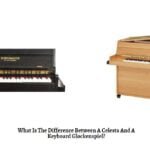The three types of beaters commonly used on a glockenspiel are soft rubber beaters, hard plastic beaters, and metal beaters, each producing different tones and suitable for various genres of music.
Soft rubber beaters
Soft rubber beaters are a popular choice for glockenspiel players because they produce a warm, mellow tone that is well-suited to classical music and other genres that require a more subdued sound.

These beaters are made from a soft, dense rubber material that absorbs some of the impact when striking the bars, resulting in a gentler, less metallic sound. Soft rubber beaters come in a variety of sizes and shapes, ranging from small, round balls to larger, cylindrical shapes with different degrees of taper.
Hard plastic beaters
Hard plastic beaters are another common type of beater used on glockenspiels. These beaters produce a brighter, more pronounced tone than soft rubber beaters and are well-suited to music that requires a more aggressive, percussive sound.

Hard plastic beaters are typically made from a dense, rigid plastic material that provides a more focused impact when striking the bars. Like soft rubber beaters, hard plastic beaters come in a variety of shapes and sizes to suit different playing styles and preferences.
Metal beaters
Metal beaters are a less common type of beater used on glockenspiels, but they can produce a distinctive, bright tone that is well-suited to certain types of music, such as jazz and contemporary pop. Metal beaters are typically made from a hard, durable metal material, such as steel or brass.

When striking the bars, metal beaters produce a sharp, metallic sound that can cut through the mix and provide a more percussive, rhythmic element to the music.
What beaters are used on glockenspiel?
Glockenspiels are typically played using hard, plastic beaters with a rounded head. These beaters are designed to produce a bright, crisp sound when striking the metal bars of the glockenspiel. The size and weight of the beaters can vary depending on personal preference, the type of music being played, and the specific characteristics of the glockenspiel being used.
What mallets do you use for a glockenspiel?
For glockenspiels, the most common type of mallets used are hard plastic or rubber mallets with a small, round head. These mallets allow for precise and clear strikes on the metal bars of the glockenspiel. Some players may also use softer mallets, such as yarn or rubber, to produce a softer, more mellow sound.
What mallets to use on xylophone?
The type of mallets used on a xylophone can vary depending on the desired sound and playing technique. Hard, plastic or rubber mallets with a small, round head are commonly used for a bright and clear sound. Softer mallets made of yarn or rubber are often used for a warmer, more mellow sound. Some players also use harder mallets with a larger head for a more percussive attack.
What are the bars on a glockenspiel made of?
The bars on a glockenspiel are typically made of metal, most commonly aluminum or steel. The thickness and shape of the bars can vary depending on the desired pitch and sound quality. Thinner bars tend to produce a brighter, more resonant sound, while thicker bars produce a fuller, warmer sound. Some glockenspiels may also have bars made of other materials such as brass or copper.
FAQs
Can I use different types of beaters on the same glockenspiel?
Yes, you can use different types of beaters on the same glockenspiel to achieve different tonal qualities and effects. However, it’s important to note that some beaters may be more suited to certain bars than others, depending on the size and material of the bars.
How do I choose the right type of beater for my glockenspiel?
The choice of beater depends on several factors, including the type of music you will be playing, the size and material of the bars, and your personal playing style and preferences. It’s a good idea to experiment with different types of beaters to find the one that produces the desired tone and response.
Can I make my own glockenspiel beaters?
Yes, it’s possible to make your own glockenspiel beaters using materials such as dowels, rubber balls, or even recycled materials. However, it’s important to ensure that the beater is properly balanced and weighted to avoid damaging the bars or affecting the tone of the instrument.
Conclusion
Ultimately, the choice of beater comes down to personal preference and the type of music you are playing. With the right choice of beater, you can achieve the desired tonal quality and response from your glockenspiel, whether you are playing classical, jazz, pop, or any other genre of music.


